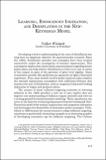Artículo
Learning, endogenous indexation, and disinflation in the new-keynesian model
Fecha
2009Resumen
Developing a better understanding of the costs of disinflation has long been an important objective for macroeconomic research. Since the 1980s, disinflation episodes and strategies have been studied extensively under the assumption of rational expectations. This assumption implies that central bank announcements regarding future policy plans can help achieve disinflation at little or no cost in terms of lost output in spite of the presence of price level rigidity. Many researchers consider this prediction too optimistic in light of historical experience. Thus, most models used for policy analysis today combine the rational expectations assumption with additional frictions that increase the cost of disinflation, such as exogenous backward-looking indexation of wages and producer prices.
Colecciones
Descargar


